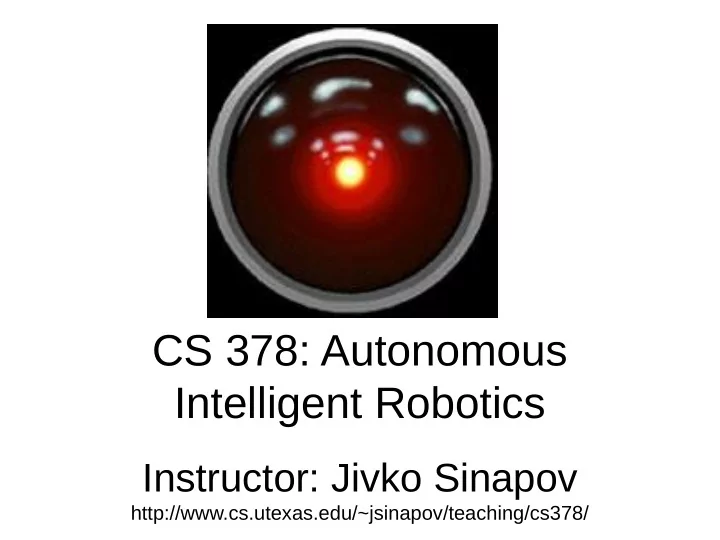

CS 378: Autonomous Intelligent Robotics Instructor: Jivko Sinapov http://www.cs.utexas.edu/~jsinapov/teaching/cs378/
Announcements A few volunteers needed for explore UT – Help setup and run the mobile robots during the open house – Help run a drone robot demo – Saturday at 10 am (event starts at 11 am) – Email me if interesting in helping out – Everyone is welcome to the event
Announcements Homework 4 is due this Friday night
Readings for this week Hoffmann, Matej, and Rolf Pfeifer. "The implications of embodiment for behavior and cognition: animal and robotic case studies." arXiv preprint arXiv:1202.0440 (2012). Hoffman, Guy. "Embodied cognition for autonomous interactive robots." Topics in cognitive science 4.4 (2012): 759-772. Michel, Philipp, Kevin Gold, and Brian Scassellati. "Motion- based robotic self-recognition." Intelligent Robots and Systems, 2004.(IROS 2004). Proceedings. 2004 IEEE/RSJ International Conference on. Vol. 3. IEEE, 2004.
Today • Robot Bodies in ROS • Homework 5 preview • Homework 4 Q & A / Help
Embodiment
Embodiment No body Body
Traditional View of AI Mainstream Science on Intelligence December 13, 1994: An Editorial With 52 Signatories, History, and Bibliography by Linda S. Gottfredson, University of Delaware “Intelligence is a very general mental capability that, among other things, involves the ability to reason, plan, solve problems, think abstractly, comprehend complex ideas, learn quickly and learn from experience .”
Traditional vs Embodied AI • Abstract intelligence • Embodiment – knowledge is implicit in the – attempt to simulate fact that we have a body “highest” human • embodiment is a foundation faculties: for brain development • language, discursive • Intelligence develops reason, mathematics, through interaction with abstract problem environment solving • Environment model – Situated in a specific environment – Condition for problem – Environment is its best solving in abstract way model – “brain in a vat”
Embodied AI Embodied Intelligence (EI) is a mechanism that learns how to survive in a environment (potentially hostile) • Mechanism: biological, mechanical or virtual agent with embodied sensors and actuators • EI acts on environment and perceives its actions • EI learns so it must have associative self-organizing memory • Knowledge is acquired by EI
Embodied AI Agent Drawing by Ciarán O’Leary- Dublin Institute of Technology
Embodied AI “Embodiment of a mind is a mechanism under the control of Embodiment the intelligence core that contains Intelligence Sensors sensors and actuators connected core to the core through communication Actuators channels.” Environment Environment Drawing and quote by Janusz Starzyk EECS, Ohio University
Embodied AI Agent Architecture Reason Short-term Memory Perceive Act RETRIEVAL LEARNING Long-term Memory INPUT OUTPUT Task Environment Simulation or Real-World System From Randolph M. Jones, P : www.soartech.com
Embodiment in Humans
Embodiment in Humans https://anagnk.files.wordpress.com/2013/03/fetal-growth.jpg
Embodiment in Humans Source: Getty Images
Embodiment in Humans
Embodiment in Humans Human Brain Human Brain 14 Years Old 6 Years Old 14 Years Old 6 Years Old at Birth at Birth Rethinking the Brain, Families and Work Institute, Rima Shore, 1997.
Synaptic Density over Time Thompson, R. A., & Nelson, C. A. (2001). Developmental science and the media: Early brain development. American Psychologist, 56(1), 5-15.
Penfield (a.k.a. Sensory) Homunculus
And its 3D analog
Origins of the word Homunculus: A miniature, fully formed individual believed by adherents of the early biological theory of preformation to be present in the sperm cell.
Discussion • Would a robot's body ever need to change over time? • Do human bodies change in addition to just growing up?
Adaptive Body Representation
Robot Bodies in ROS
Position and Orientation in 3D
Quaternions
Roll – Pitch – Yaw [http://www.chrobotics.com/library/understanding-quaternions]
Roll – Pitch – Yaw
Roll – Pitch – Yaw
Converting between Quaternions and RPY
Pose Tutorial using rviz
URDF Tutorial • http://wiki.ros.org/urdf/Tutorials
Homework 5 Prerequisites: – URDF tutorials 3.1 – 3.3 – (Optional) TF tutorials in C++ and URDF tutorials 2.1 – 2.5
Homework 5 • Part 1: Building your own robot – Must have at least 6 joints • Part 2: Robot training session – Look for signup sheet in Announcements – Each session will last up to 1 hour involving 1 mentor and 4-5 students – 6 to 8 sessions will be schedule throughout next week • Officially out tomorrow
Homework 4: Q&A / Help
THE END
Recommend
More recommend